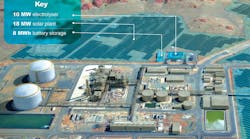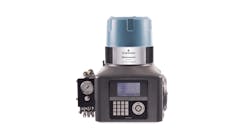Source: Yokogawa
One of the earliest commitments to sustainability in the process industries was made in 2017 by Yokogawa, which pledged to achieve net-zero emissions by 2050 and transition worldwide to a circular economy by the same year, along with maintaining the well-being of its employees, customers and communities.
“I’ve been at Yokogawa for more than 30 years, so I know we’ve been involved in the energy sector for a long time. However, we’re now developing new energy sectors that are very different from our usual refining and petrochemical processes,” says Gou Iwata, head of business strategy and water business development at Yokogawa’s Energy and Sustainability division. “These projects aren’t just photovoltaics and wind, which are getting bigger and bigger They’re mostly smaller than our usual pumps and compressors. In either case, they need suitable process automation and controls, which can also meet Scope 1, 2 and 3 goals for reducing CO2 emissions and help save energy, too.”
For example, Gou reports that Yokogawa Australia recently provided an energy management system (EMS) for a 10-MW electrolyzer, 18-MW solar plant, and 8 MWh battery energy storage system (BESS) at the Yuri Green Hydrogen Project in the Pilbara region of Western Australia. The project is a joint venture between Mitsui and Engie Renewables Australia Pty., Ltd., with engineering, procurement, construction and commissioning (EPCC) services provided by Technip Energies and Monford Group Pty., Ltd.
The Yuri facility will use solar power to produce up to 640 tons per year of green hydrogen, which will be used as a feedstock to produce green ammonia by 2030 at an adjacent ammonia plant operated by Yara Pilbara Fertiliser (YPF) Pty., Ltd., which is a subsidiary of Yara International ASA, one of the world's largest producers of nitrogen-based, mineral fertilizers.
Yokogawa’s subsidiary, PXiSE Energy Solutions, is developing the EMS for the solar power plant, BESS and electrolyzer. It will be combined with an integrated control system (ICS) centering on a Collaborative Information (CI) Server that Yokogawa will also provide as part of the project’s first phase. The EMS will manage the Yuri facility’s inverter and batteries, while the ICS and related PLCs will manage its RTUs, SCADA system and PXiSE software. Once these systems are installed and integrated, the plant's renewable energy production will be managed autonomously to ensure consistent stability and power quality based on the ammonia plant’s operating requirements, local weather and other factors (Figure 1).
“We’ve already spent about a year integrating Yuri’s control systems, including PXiSE’s EMS, which is especially important because this green-hydrogen process requires consistent, high-quality electricity to produce high-quality hydrogen,” explains Gou. “This can be difficult for a solar plant due to clouds and other factors. This is where battery storage comes in to cover gaps and maintain a steady power supply, while BESS relies on PXiSE’s high-speed controls.”
Optimizing incineration in Poland
In another sustainability project, Yokogawa recently installed FuzEvent combustion control software from its Dublix Technology ApS subsidiary at Krakowski Holding Komunalny SA’s waste-to-energy (WtE) plant in Krakow, Poland. Starting operations in 2016, this WtE plant is the largest in Poland, and can incinerate 245,000 tons of municipal water per year, and generate 100,000 MWh of electricity and 1 million gigajoules (Gj) of heat.
However, burning municipal waste is tricky because its moisture content and density vary, so it’s difficult to achieve stable incineration for power generation by using regular PID control. FuzEvent enables centralized incineration management with an integrated production control system, which can be added to existing control systems without adding new sensors, changing established control structures, or making costly modifications to equipment. By tackling the root issues of municipal waste combustion and ensuring stable combustion, it lets plants operate at full capacity, and increase the electricity and steam they produce, while also incinerating more waste.
At the Krakow facility, FuzEvent optimizes KHK’s DCS performance via OPC UA networking, and can be configured for semi-automatic, advisory or fully automated operations, which can help clean exhausts and emissions to better comply with increasingly strict regulations. A performance test at KHK found that FuzEvent:
- Increased the WtE plant’s incineration volume by 2.5%, which is equivalent to 5,500 tons annually if the plant is operating at full capacity;
- Kept harmful exhaust-gases emissions within government-set limits; and
- Ensured stable steam flow for optimal steam-turbine operations, which maximized electricity generation for the national grid and district-heating supply to Krakow.
“Because sustainability depends on who you are and what you’re doing, we ask potential users if they’re aware of the energy they’re using to make their products,” says Gou. “Many users aren’t measuring energy parameters as closely as needed. They may know their overall energy consumption, but they aren’t measuring per machine or unit produced. So, we suggest they consider digitalizing, getting more granular, and measuring the electricity, water, steam and/or compressed air used per unit, so they can compare production lines. We do the same for Yokogawa’s manufacturing areas, and each department has energy budgets and sustainability goals.”
Gou reports these efforts are aided by Yokogawa’s newly launched OpreX Carbon Footprint Tracer software, which gathers and analyzes sensor data. “We looked at one of our production lines that was supposedly shut down during lunch, and found that it was still using lots of power. We evaluated its performance with our software, pinpointed leaks in its compressed air lines, and found it was also leaking water elsewhere. Any user can track and optimize parameters like this, and deal with leaks or other issues, beginning with easy items and then moving on to harder ones. Many users traditionally leave equipment running for perceived quality or safety issues, but there’s proof that they don’t need to. Likewise, many plants turn on heating equipment too early in the day, when they could use timers instead.”
Gou adds that sustainability can also be achieved by considering how process applications and facilities are designed, and applying system integration to balance production with some added requirements. “Many users have dealt with peaks in electricity availability before, but with solar power, that peak may shift to 2-3 p.m., and they may need battery coverage to shift it,” says Gou. “PXiSE is good at high-speed frequency and voltage control, and making adjustments in five minutes, which is similar to using model-predictive control and digital twins. Yokogawa comes from the operations technology (OT) side, so we’re all about collecting and using measurements for optimizing operations. Sustainability also uses measurements, and communicates them for the future of our planet.”





